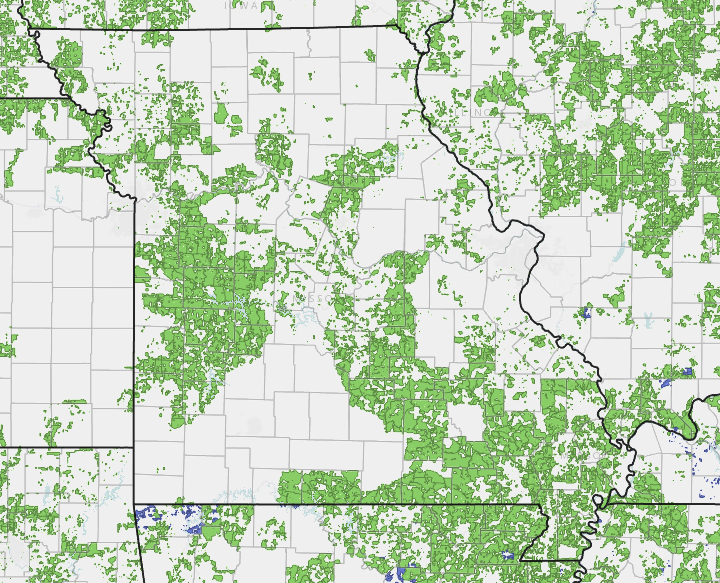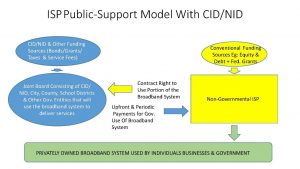Don Tottingham, longtime Mayor of Houston, Missouri, loved his City and thought it was a great place to raise a family. But he also recognized it had a major infrastructure issue: its residents and most small businesses lacked an adequate, reliable, high-speed internet connection.
The Vision
Mind you, Houston, Missouri, a city of approximately 2100, located in the south-central part of the state, is not entirely without high-speed internet service. Some businesses and many schools, libraries and other public institutions had the money needed to fund special, high-speed internet connections, but upon investigation Houston public officials found that the commercial providers who offered this service to businesses in the City, could not make a “business case” for extending service to all the individual residences and small businesses in the City.
This situation may sound familiar to many small towns, subdivisions, and even some neighborhoods in larger cities. However, what is unusual is that Houston’s local officials decided to do something about the problem. They decided to build a fiberoptic internet network that will offer service to all residents and businesses in the City.
I spoke recently with Houston City Administrator, Scott Avery (via Zoom) to learn more about the City’s vision and lessons learned as the project has moved forward.
When we spoke, the City’s network was under construction: an 18-mile fiberoptic cable “ring” around the community had been completed, internet access for the City’s new network with two separate providers had been secured, and work was underway on the second stage of a four-stage neighborhood build-out to homes and businesses throughout the City.
Service has been offered to residences and businesses in the completed sections of the City beginning in March 2021, and when the network is finally completed (expected by year-end), every home and business in the City will have the option of connecting to the internet at speeds of up to 1 gigabit per second!
Community Outreach – Meeting the Needs of the Community
Mayor Tottingham lost his battle with cancer in July 2019, but by that time the City had already hired an engineering firm to conduct an internet feasibility study. The results of that feasibility study and a key component, a community survey, became available at about the time the time Scott Avery came on board as City Administrator in September.
Scott noted two key findings of the community survey. First, 78% of respondents said they would subscribe to reliable internet service offered by the City. This of course was strong confirmation of public support for the City to move forward with municipal broadband. Second, the survey showed that the overwhelming concern for residents and businesses was to have reliable internet service– meaning service that was robust enough to allow them to connect online and have confidence that the connection would remain stable for as long as it was needed. This led the City to intentionally construct a network designed to be highly reliable and capable of expanding to meet both current and future needs of residents and businesses.
Scott observed that the community outreach effort was crucial not only for Houston’s leaders, but for any community that wants to address the lack of high-speed internet access and adoption. “We could sit here in city hall and guess all the time without actually understanding what services they want the City to provide.” He added, “Having the survey gives you a chance to ‘paint the picture’ to let folks know what you are doing.” and that “helped answer the questions Aldermen had when considering whether to make the investment.”
Houston’s project is closely tied to its municipal electric utility system. Funds from the electric system have financed the expansion; city employee linemen have been cross-trained to install and repair fiber; the fiber is mounted on City-owned poles; and billing and back-office administration are incorporated with those already used for the City’s electric, water, and sewer utilities. Once fully operational, the network is expected to deliver better utility and other government services to the community, as well as provide the City’s residents and businesses reliable high-speed internet.
“In the Trenches” – Building a Fiber Network
In early 2020, based on the findings from the survey and the feasibility study, the City decided to move forward with a City-owned and operated internet network. It selected a contractor through a request for qualifications process, and secured contracts to connect the City’s network to the internet from two separate providers. Scott’s experience in emergency services, and the community’s concerns about reliability, led to the decision to have a second provider for the City’s network. By doing this, the City has redundant access to the internet, so that a service failure with one provider would not cause the City’s network to go down, as the other provider’s capacity alone was more than that needed to service the City’s users. The City also took advantage of favorable pricing to buy more capacity (bandwidth) from these providers than was strictly necessary based on the engineer’s design. The goal was to build a system that could easily grow to meet increases in demand or perhaps a new business such as a data center that might need much higher levels of bandwidth.
The City published pricing and service levels in 2020 before network construction began. It now offers a range of service options for households ranging from $30 a month for 25Mbps (upload and download) to $90 a month for gigabit level service (1000 Mbps). Business customer options range from $75 to $250 per month but provide the customer priority routing over the network.
When it created the various options and pricing, the City focused on two considerations. First, what was the minimum level of service citizens needed to do most household tasks such a streaming video and working or taking online classes from home. Even for individuals that select the lowest service level, their connections speeds should be sufficient for those purposes. Second, the service is priced at a level sufficient to operate and maintain the City’s network over the long term, but with no expectation of making a profit. As Scott put it — “the goal, the focus, all along is that a single mom with four kids at home – trying to get them an opportunity that they wouldn’t have had otherwise, and I think this fiber broadband and an online education opens doors for people in this community more than anything else because it attaches them to the outside world.”
With this amount of advance planning and help from outside experts, existing right-of-way, poles throughout the City to run fiberoptic cable, and a city staff experienced in operating other utilities, you might expect things would have gone relatively smoothly. Scott was quick to admit that wasn’t the case. “We started construction in March of 2020. I don’t know if you heard what happened in March of 2020, but there was a shut down from this thing called COVID.” As I laughed, he pointed to his graying hair and observed, “I had brown hair when we started this project.”
Joking aside, the COVID lockdown initially stopped and then slowed the progress on the project. Once things began to reopen, the City was faced with labor delays and shortages of fiberoptic cable and related equipment needed to construct the network. This problem is not unique to Houston, it has plagued even the largest internet providers throughout the United States. The City’s network build-out is now 14 months behind schedule, but in large part because City employees are now able to handle fiber installation even if the outside contractor is delayed, they are in a much better position to move forward to complete the build out. The City has also discovered a few “work arounds” to mitigate the supply chain issues. For example, it recently was able to fill a need for 65 “fiber dead-end connectors” by sourcing what was needed from several suppliers that could fill part, but not all, of the City’s order.
These delays also have reduced the number of subscribers from those initially projected, but the City believes this will be reversed once the entire network is complete and folks understand the value of service being offered. Noting the public’s problem with unreliable internet, Scott observed that the City’s new network has not suffered a service outage since it “went live” in some sections of the City in March.
Lessons Learned
A final list of “lessons learned” from Houston’s approach awaits completion and full operation of the new network. One lesson that Scott offered was the need to make certain that engineers and other outside advisors understand that municipal leaders, even those that lead a city’s IT department, likely do not “know what they don’t know” when it comes to designing and constructing an internet network. Open communication is critical to avoid unpleasant surprises for any community contemplating a broadband project. Other lessons he mentioned were more closely tied to the extraordinary challenges of the COVID pandemic. For example, the City’s solution to supply shortages previously described, and the need to develop effective strategies to keep the project moving forward even when contractors are stretched too thin and face severe labor shortages.
What seems equally clear is that any city or county undertaking a project like this needs to have a clear vision of its ultimate objective, a public mandate to move forward, and a tenacious innovative staff that remains calm and focused on the ultimate objective in the face of the unforeseen challenges and setbacks. Here Scott’s experience in emergency services likely was a huge plus for the City. As he put it – no matter how many problems come your way, at least you know nobody is going to die, and that certainly helps keep things in perspective.
There is also one final “lesson” for other communities facing similar challenges of inadequate internet service that may not be as apparent: Houston’s approach may not be appropriate or necessary to address the problem. Not every community will have the experience, leadership, and resources needed to construct and offer-high speed internet to every home and business as a municipal utility. Even in communities that do, the citizens may not want their city or county to take on this role.
However, that doesn’t mean there isn’t an appropriate role for local government to play in efforts to close the digital divide. Every city and county in the state has received federal funds to plan and pay for necessary broadband infrastructure. There are variety of contractual arrangements that local governments can use to encourage the expansion of privately-owned high-speed internet for unserved and underserved areas. However, public funds and public support for private internet expansion needs to have a public purpose — it needs to meet needs of the citizens of the community for more effective government, and real improvements to the health, education and economic well-being of the community. The first logical step in that process is to develop a comprehensive plan that identifies and meets the needs of the community.

